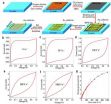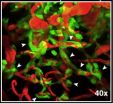(Press-News.org) EAST LANSING, Mich. -- In the past half-century, fear of crime in the United States has fueled "white flight" from big cities, become known as a quality of life issue and prompted scholars and law enforcement experts to address ways of reducing this fear.
But a study by a Michigan State University criminologist challenges this longstanding theory by arguing that a healthy fear of crime is, in fact, a good thing.
The study, published online in the journal Justice Quarterly, suggests adolescents who are more fearful of crime are less apt to become victims and offenders of violent acts. Essentially, fearful youth tend to avoid potentially dangerous people, locations and activities such as drug-fueled parties, said Chris Melde, MSU associate professor of criminal justice.
Instead of trying to reduce this fear, Melde said law enforcement agencies should focus on direct anti-crime initiatives and providing details on which crimes are most likely to occur, and where. This would help citizens become better informed on issues that could affect their routine activities and safety.
"If we're going to reduce crime and victimization, we should present people with an accurate assessment of crime and delinquency in local areas," Melde said. "Policies aimed at fear reduction are not likely to be effective crime-reduction strategies."
Melde studied more than 1,600 youth from across the United States during a one-year period. He found that respondents who reported more fear were less likely to be involved in violent acts such as assaults, robberies and gang fights.
Interestingly, the results held for both victims and offenders. That's because the two groups often come from the same pool of people, which is called the "victim-offender overlap." While there are "pure" victims, Melde noted, disentangling victim from offender can come down to determining who started a street fight.
The findings relate to situations people can avoid, Melde said, and not to the types of victimization that deal with one person's power over another, such as child abuse and domestic violence.
"We should leave fear alone as a natural response to crime unless it reaches that chronic or phobic level," Melde said. "That's when you want to intervene."
INFORMATION: END
Scared of crime? Good.
2014-08-12
ELSE PRESS RELEASES FROM THIS DATE:
ADHD, substance abuse and conduct disorder develop from the same neurocognitive deficits
2014-08-12
This news release is available in French. Researchers at the University of Montreal and CHU Sainte-Justine Research Centre have traced the origins of ADHD, substance abuse and conduct disorder, and found that they develop from the same neurocognitive deficits, which in turn explains why they often occur together. "Psychopathology exists on multiple continua of brain function. Some of these dimensions contribute to a multitude of problems, others contribute to specific problems. Together, they explain patterns of comorbidity such as why ADHD and conduct problems co-occur ...
Loss of eastern hemlock affects peak flows after extreme storm events
2014-08-12
The loss of eastern hemlock could affect water yield and storm flow from forest watersheds in the southern Appalachians, according to a new study by U.S. Forest Service scientists at the Coweeta Hydrologic Laboratory (Coweeta) located in Otto, North Carolina. The article was just published online in the journal Ecohydrology.
"Eastern hemlock trees have died throughout much of their range due to the hemlock woolly adelgid, an exotic invasive insect," said Steven Brantley, a post-doctoral researcher at Coweeta and lead author of the paper. "Though this insect has decimated ...
Graphene-based planar micro-supercapacitors for on-chip energy storage
2014-08-12
The rapid development of miniaturized portable electronic devices, such as micro-electromechanical systems, microrobots and implantable medical devices, has stimulated intense demand for micro-scale power sources. Although miniaturized micro-batteries that store energy by redox reactions provide the most frequently used micro-power source for current portable electronics on chip, their limited lifetime (hundreds or thousands of cycles) and low power density rule out applications that require high power over a short timeframe.
Micro-supercapacitors (MSCs) with a short ...
Researchers prove stability of wonder material silicene
2014-08-12
An international team of researchers has taken a significant step towards understanding the fundamental properties of the two-dimensional material silicene by showing that it can remain stable in the presence of oxygen.
In a study published today, 12 August, in IOP Publishing's journal 2D Materials, the researchers have shown that thick, multilayers of silicene can be isolated from its parent material silicon and remain intact when exposed to air for at least 24 hours.
It is the first time that such a feat has been achieved and will allow scientists to further probe ...
Prognosis of pneumonia: value of respiratory rate often overlooked
2014-08-12
Pneumonia – a severe lung infection – is the most common disease calling for hospital admission. More than one out of ten pneumonia patients die of the disease. Thus it is vital to accurately predict and closely monitor the clinical course. Here, measuring the respiratory rate – the number of breaths a person takes in a minute – provides valuable information. However, far too little use is still being made of this vital sign in clinical practice, as Richard Strauß and co-authors conclude in their recent study in Deutsches Ärzteblatt (Dtsch Arztebl Int 2014; 111: 503).
The ...
Hijacking the brain's blood supply: tumor discovery could aid treatment
2014-08-12
ANN ARBOR, Mich. — Dangerous brain tumors hijack the brain's existing blood supply throughout their progression, by growing only within narrow potential spaces between and along the brain's thousands of small blood vessels, new research shows for the first time.
The findings contradict the concept that brain tumors need to grow their own blood vessels to keep themselves growing – and help explain why drugs that aim to stop growth of the new blood vessels have failed in clinical trials to extend the lives of patients with the worst brain tumors.
In fact, trying to ...
Lead released from African cookware contaminates food
2014-08-12
San Francisco and Yaoundé – Lead levels in foods prepared in aluminum pots from Cameroon exceed U.S. guidelines for lead consumption according to a new study published this month. A typical serving contains almost 200 times more lead than California's Maximum Allowable Dose Level (MADL) of 0.5 micrograms per day.
Researchers at Ashland University and Occupational Knowledge International tested 29 samples of aluminum cookware made in Cameroon and found almost all had considerable lead content. This cookware is common throughout Africa and Asia and is made from recycled ...
Changes in motor function in the unaffected hand of stroke patients should not be ignored
2014-08-12
With effective rehabilitation, stroke patients can partially regain their motor control and continue their activities of daily living. Motor function changes in the unaffected hand of stroke patients with hemiplegia. However, these changes are often ignored by clinicians owing to the extent of motor disability of the affected hand. Research group at Shanghai University of Sport, China led by Prof. Zhusheng Yu based on finger tapping frequency and Lind-mark hand function score have found that the motor function of unaffected hands in stroke patients was poorer than that ...
Neuroprotective effect of tongxinluo: a PET imaging study in small animals
2014-08-12
Tongxinluo has been widely used in China for the treatment of acute stroke and for neuroprotection. Research group at Encephalopathy Center, Guangdong Provincial Hospital of Traditional Chinese Medicine, China intragastrically administered Tongxinluo superfine powder suspension or its vehicle to rats for 5 successive days before middle cerebral artery occlusion. There are many advantages of using small animal PET for drug research. First, the results of the study in vitro cannot be directly applied to human studies, while small animal PET imaging methods and results can ...
ASU-Mayo researchers use calcium isotope analysis to predict myeloma progression
2014-08-12
TEMPE, Ariz. – A team of researchers from Arizona State University and Mayo Clinic is showing how a staple of Earth science research can be used in biomedical settings to predict the course of disease.
The researchers tested a new approach to detecting bone loss in cancer patients by using calcium isotope analysis to predict whether myeloma patients are at risk for developing bone lesions, a hallmark of the disease.
They believe they have a promising technique that could be used to chart the progression of multiple myeloma, a lethal disease that eventually impacts ...



